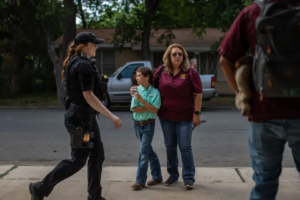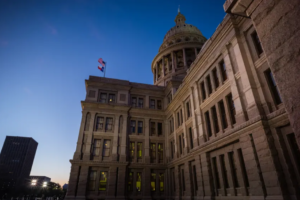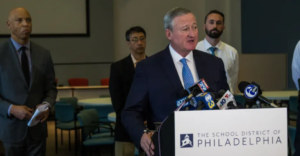Detroit school district leaders brought their $700 million rebuilding plan to the community Tuesday, with more than a dozen people questioning them about the timeline; the plan’s impact on students, teachers, and individual schools; and the potential sale of the vacant Cooley High School building.
Tuesday’s meeting, the first of seven community feedback meetings, sought input on the district’s plans for Cody, Henry Ford, and Mumford high schools, as well as the elementary and middle schools whose students will attend those high schools. The district’s proposal is using a sizable portion of the $1.2 billion of federal COVID relief funding.
Attendees were mostly receptive to the district’s plan to rebuild or renovate some buildings, close a handful of schools, sell or demolish vacant properties, and address other long-delayed building improvements.
The district would spend roughly $270 million to address building needs in those areas, including:
- Constructing new buildings on the current sites of Cody High School and Paul Robeson/Malcolm X Academy.
- Reopening Paul Vetal Elementary, which closed in 2011, with an expanded pre-kindergarten program.
- Building new additions at Charles Wright Academy, Communication and Media Arts High School, and John R. King Academy.
- Closing Ann Arbor Trail Magnet Elementary-Middle School and Thurgood Marshall Elementary School by phasing out enrollment over the next several years.
Naomi Cliett-Jackson, vice president of the Pershing High School Alumni Association, thanked Detroit Superintendent Nikolai Vitti for “fulfilling the needs of our community” by asking for community feedback. Vitti said the district will review public input from the meetings before handing their recommendations to the board for final approval in May or June.
“How you can best inform our thinking is tell us you like the overall plan, and then tell us what you have questions about, what you have concerns about, what you disagree with, meaning you believe that more investment should go to this school rather than that school, or you believe that a certain school should be phased out that’s not a part of the plan,” Vitti said.
Under the plan, construction and renovations would begin by the fall of 2023, with all projects completed by the fall of 2025. Student enrollment, citywide population trends, and school demand for programs, Vitti said, were some of the main metrics the district was using to determine its projected investments in neighborhood schools.
District is prepared to sell Cooley, other vacant buildings
The district’s recommendations to either sell, demolish, or rehab vacant school buildings is based on building assessments by Detroit-based architectural firm Interboro Partners, projected demographic growth in the vacant properties’ area, costs to renovate and maintain the building, and the negative impact of neighborhood blight.
During his presentation, Vitti said he would recommend the sale of Cooley High School, but does not have a specific buyer in mind. The building has been vacant since 2010.
“It doesn’t make sense to keep the property if there seems to be a willingness to purchase it,” Vitti said. Detroit nonprofit Life Remodeled announced last fall that it had plans to bid on Cooley High School.
At recent board meetings, Cooley alumni, community members, and nonprofit leaders have asked the district to announce its plans for the site.
Kenia Jones Sims said during the facility meeting that she would like to see Cooley High School revitalized into a community hub like Durfee Innovation Society. In 2017, the district leased the previous site of Durfee Elementary-Middle School to Life Remodeled to repurpose the building.
Chet Pitts, a Cooley alumni and parent of current Detroit school district students, advocated for the former high school to be brought back to life. But that would cost $50 million, Vitti said.
“It just doesn’t make economic sense or enrollment sense to build a new Cooley when it’s not clear that there are high school kids that will go to Cooley,” he said, explaining that rehabbing Cooley would be “taking money away from buildings that have extraordinary need.”
If the board approves the facilities plan, the district would begin to sell vacant properties such as Cooley in July or August, Vitti said.
Concern over proposed Ann Arbor Trail closure
Vitti said he is recommending closing Ann Arbor Trail because the building has the capacity to serve 400 students but only enrolls 268, and the cost of renovating the building would be $10 million.
“That is a large amount of money for a small school,” he said. In the district’s proposal, current Ann Arbor Trail students will be able to graduate while incoming students would attend nearby Dixon Educational Learning Academy.
Commenters during the presentation raised concerns over the job status of Ann Arbor Trail teachers.
All teachers and support staff affected by building closures or consolidations will continue to work within the district, Vitti said, either at their grade level/program or the school their students transfer to.
Other commenters said they worried about the safety of students who would have to walk through Rouge Park if they transferred to Dixon.
“Ann Arbor Trail students will have to travel across a 2-mile park to walk to Dixon,” wrote Gina Ross. “Please do not combine these schools. This will be a train wreck.”
“We are not going to just rip a Band-Aid off and move students randomly to a nearby school,” Vitti said. “The students that are currently there can stay there.”
The district would consider placing security staff on walking routes or partnering with Detroit Police Department if students need protection on their way to and from school.
Thurgood Marshall would stop enrolling new students and close by 2025. Incoming students who would previously have attended the elementary school would have the option to attend the newly built Paul Robeson/Malcolm X Academy or Mary McLeod Bethune Elementary-Middle School.
Once the facility plan is finalized, the district will redesign transportation routes to reflect the changes. The district’s current transportation policy provides transportation to K-8 students who reside more than three-quarters of a mile away from a school.
This article was originally posted on Detroit’s facility plans draw praise and concern at community meeting






Be First to Comment